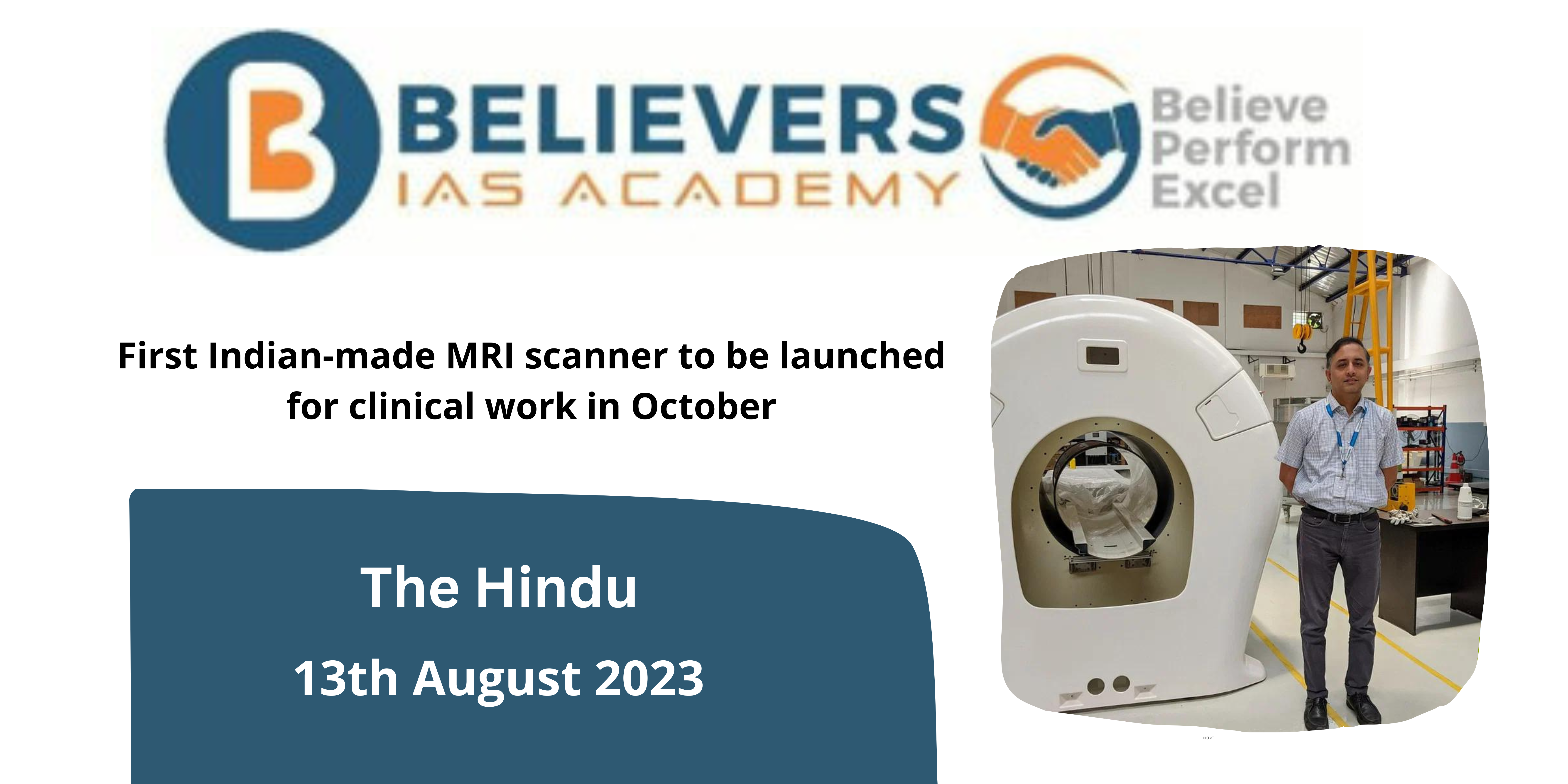First Indian-made MRI scanner to be launched for clinical work in October
Context
In place of liquid helium, a new type of MRI scanner uses the far more accessible, less expensive liquid nitrogen to swiftly chill the magnets. In October, the Sathya Sai Institute of Higher Medical Sciences in Bengaluru will introduce the first clinically validated product of the first made-in-India MRI scanner, which was created by the Bangalore-based Voxelgrids Innovations Private Ltd.
What is the speciality of the Indian MRI scanner?
- Liquid Nitrogen cooling: Liquid nitrogen is used as a cooling agent for the superconducting magnets in the new Indian MRI scanner created by Voxelgrids Innovations Private Ltd.
- Alternative to Liquid Helium: This scanner takes the place of the customary usage of expensive, scarce, and low-boiling-point liquid helium.
- Superconducting Magnets: Similar to conventional MRI scanners, this novel design produces a powerful magnetic field for medical imaging.
What are the advantages of using Liquid Nitrogen?
- Cost-Effectiveness: Compared to liquid helium, liquid nitrogen is more affordable and accessible, which can lower operational costs for healthcare facilities.
- Accessibility: Liquid nitrogen is more readily available than liquid helium, making it a sensible alternative, particularly in areas with a limited helium supply.
- Safety: Some of the safety risks connected with liquid helium are mitigated by the greater boiling point of liquid nitrogen, which makes it safer to handle and store.
- Simplicity: Liquid nitrogen cooling is more straightforward, which could make maintaining and running the MRI scanner easier.
Why is using Helium no longer a viable option?
- Supply and Cost: Helium is a scarce material whose supply is susceptible to uncertainty, which may result in supply problems and price swings. This may make it more expensive to use and less available, especially in areas with scarce helium resources.
- Helium Shortages: Because of its limited supply and high demand in a variety of fields, including medicine, science, and industry, helium has occasionally been in short supply in the past.
- Boiling Point and Handling: Helium has a very low boiling point (about -269°C or -452°F), which makes handling and storing it difficult. Equipment design and operation become more complicated as a result of the need for cryogenic systems to maintain such low temperatures.
- Safety Concern: Helium is typically safe to handle, but the possibility that it could displace oxygen in confined areas and its extremely low temperature pose safety issues to anyone using the equipment.
- Environmental Impact: Concerns concerning helium’s long-term sustainability and depletion have been raised because of its limited availability and relevance in numerous scientific and medicinal uses. This has motivated researchers to look for more environmentally friendly solutions.
- Local Production: Due to geopolitical or financial constraints, some nations may only have restricted access to helium. Creating locally producible alternatives, such as liquid nitrogen, can increase technical self-sufficiency.
What is the benefit of having an Indigenous MRI Scanner?
- Technological Self-Reliance: The creation of an in-house MRI scanner demonstrates a nation’s capacity for invention, design, and domestic production of sophisticated medical equipment. This lessens reliance on foreign technology and increases reliance on domestic technology.
- Reduced Costs: Because import costs, currency fluctuations, and import taxes are frequently lower with domestic manufacture, there are often cost savings. For patients and healthcare professionals, this may result in more affordable medical supplies and services.
- Customization and Adaptability: Native MRI scanners can be modified to meet the unique needs and specifications of the regional healthcare system. The equipment is more compatible with the infrastructure, medical practices, and patient demographics in the area thanks to this modification.
- Accelerated Innovation: Research, development, and innovation are encouraged by domestic development. Local technological development can result in ongoing enhancements, speedier medical progress adaptability, and faster incorporation of cutting-edge features.
- Economic Development and Job Creation: The development of a local medical technology sector opens up positions in research, engineering, manufacturing, sales, and maintenance. This strengthens the skilled workforce and promotes economic progress.
- Knowledge and Skill Development: There are many different scientific and engineering disciplines involved in creating an indigenous MRI scanner. This procedure strengthens educational programs in linked subjects, fosters research collaboration, and cultivates local knowledge.




